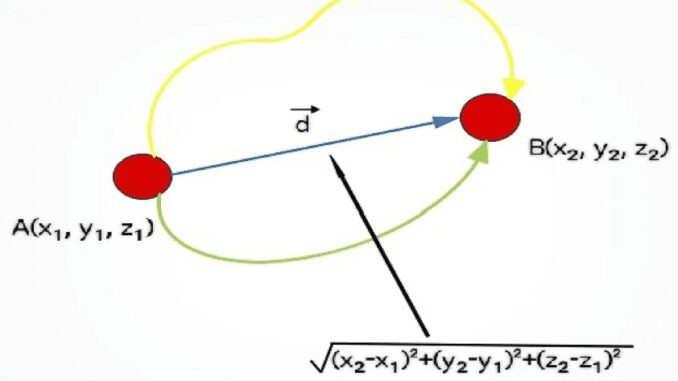
Know in one minute about the Displacement formula
∆x = x₂ – x₁ Where, x₂ = final position of the body x₁ = Initial position of the body
|
Introduction of Displacement formula
Displacement is the term of kinematics in which we calculate the length when the position of the object or particle changes. The displacement formula is a formula with the help of which we calculate the shortest length of an object or a particle when its position changes. This shortest length is called displacement.
In this article, we will learn about displacement and derive the displacement formula as well as its use and examples.
How to describe the position?
Position describes the presence of a body at a place. In order to actually tell the position of a body, we need a frame of reference. Normally when we have to tell the position of a body, we consider Earth and other objects adjacent to the Earth as the frame of reference.
For example, A car is first with a tree then that car goes to the right side 30 meters In this case, we will be the frame of reference to tell the position of the car.
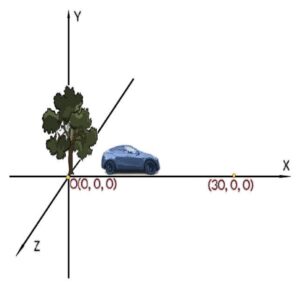
This position is mathematically described according to three axes which are X, Y, and Z axis. It is denoted by (x,y,z) where x,y, and z are the lengths from the origin respectively.
If we consider the position of the tree as the origin (0,0,0), then the position of the car after moving 30 meters to the right will be (30, 0, 0).
It is not necessary to use all three axes to describe the position of a body, as in the example only one axis would be sufficient to describe the position of a car.
Sometimes the frame of reference itself is a moving body, that is, in such a situation there will be no earth frame of reference.
For example, The frame of reference for a person moving inside the train will be the train itself.
What is displacement?
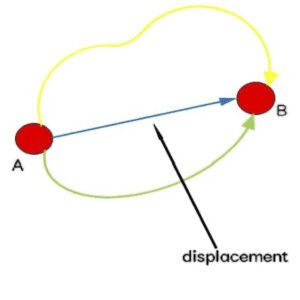
If an object or particle moves from one place to another, it is actually changing its position. That object or particle follows some path to change its position. Displacement is the length of the shortest path when the position of that object or particle changes.
In other words, displacement is the shortest length between two positions.
- Displacement takes place in a straight line only.
- Displacement depends only on the initial and final position of the body, no matter along which path the body changes its position, displacement does not depend on any path.
- Displacement can be positive, negative, or zero.
- Displacement is a vector quantity so it has direction and magnitude.
- Displacement is represented by
 or, and its unit is a meter in the S.I. system and a centimeter in the C.G.S. system.
or, and its unit is a meter in the S.I. system and a centimeter in the C.G.S. system.
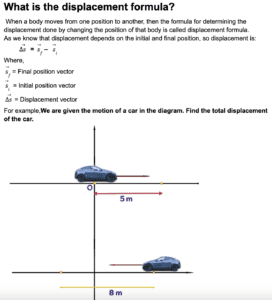
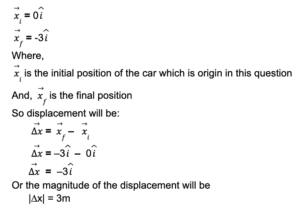

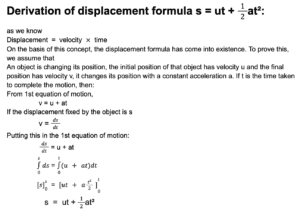


Difference between distance and displacement
Distance and Displacement both are physical quantities that are used to measure the length covered by a body during the motion. But they have a huge difference between them, which is given below:
Key points |
Distance |
Displacement |
| Definition | Whatever path is covered by a body in motion, the length of that entire path is called distance. | The shortest distance between the initial and final position of the body is called displacement. |
| Quantity type | It is a Scalar quantity. | It is a Vector quantity. |
| Unit | Its SI unit is a meter(m). | Its SI unit is also a meter(m). |
| Direction | It doesn’t have direction. | It has direction. |
| Formula for calculation | Distance = speed X time | Displacement = velocity X time |
| Relation | The magnitude of distance is always greater or equal to displacement. | The magnitude of displacement can be smaller than the distance. |
| Positive or negative | Distance can’t be negative, it always has a positive value. | Displacement can be positive, negative, or zero. |
| In closed loop | It has some positive value when an object moves on a closed loop. | It has zero value on a closed loop. |
Q&A
1. What is the displacement formula?
Ans. The formula used to find the displacement done during the motion of a body is called the displacement formula.
The difference between the final and initial positions of the body represents the displacement:
∆x = x₂ – x₁
Where,
x₂ = final position of the body
x₁ = Initial position of the body

Written By: Amber Soni

